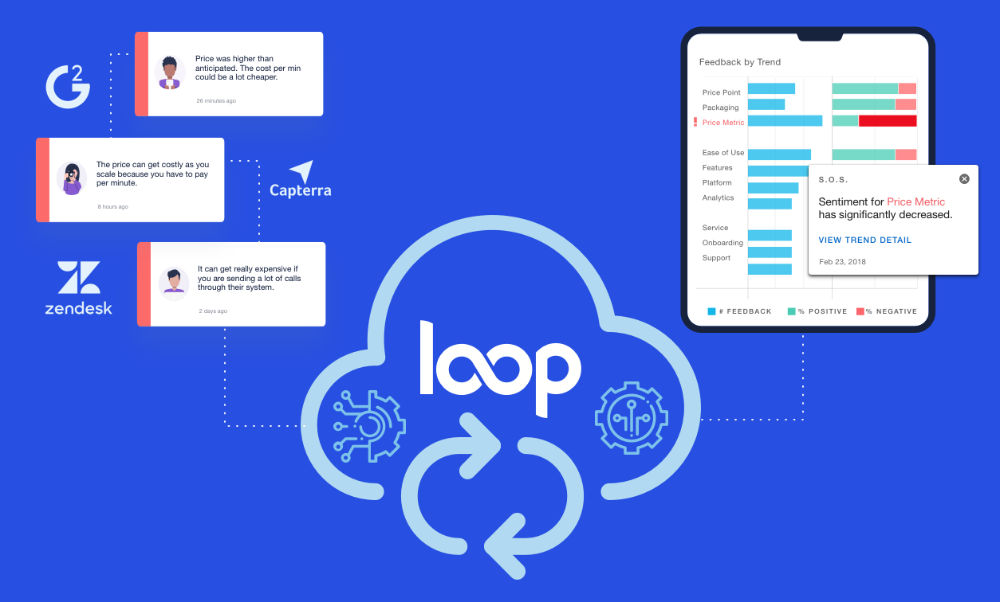Home » [SaaS Marketing] How to write more persuasive messages, faster with voice of the customer data
[SaaS Marketing] How to write more persuasive messages, faster with voice of the customer data

Andrew Yedlin
B2B & SaaS Conversion Copywriter, AndrewYedlin.com

Writing is hard.
Writing to market your SaaS product is even harder.
There are so many things to say about your product, but when it’s time to sit down and write, you struggle to find the right words.
Or you end up with too many words and don’t know what to cut.
Finally, your blood, sweat and tear-stained writing makes its way to an opinionated stakeholder who can undo all your work with a single comment:
“Let’s try another direction.”
The worst part? Who knows if that messaging document or web page you wrote will actually resonate with your audience and deliver the results you seek.
It turns out, there’s a better way for marketers to approach writing.
As you’ll soon discover, some of the world’s best copywriters have been using this approach to writing with astonishing success (and metrics to prove it).
This approach will…
- Dramatically cut the time it takes you to write effective messages and keep you from ever having to write from scratch
- Give you a repeatable process for finding the messages that are most likely to persuade your audience (instead of trying to dream them up on your own)
What is this sorcery?
It’s a voice-of-customer-driven approach to finding and writing high-impact messages.
With this approach, you’ll take your customers’ own words — from surveys, interviews, review sites and elsewhere — and mine them for messages that persuade and resonate with your prospects and customers.
Not only does this save you from the slow, painful process of writing from scratch…
…it also saves you from fruitless guesswork by revealing the messages your audience needs to hear. Which means your marketing efforts can produce…
- More and better leads
- More paying customers
- Less churn
- And other growth outcomes
In this article, we’ll cover…
- What “voice of the customer” (VOC) is
- What to look for in your VOC data
- How stealing words from customers can improve your conversion rates
- A quick and dirty way to write more effective messages using VOC today
Let’s start with a deeper look at VOC-driven messaging. We’ll explore how it saves you time and improves your chances of success. Finally, you’ll see how you can start using VOC in your messaging today.
What is voice of the customer (VOC)?
There are some complex definitions of “voice of the customer” out there. So for the sake of this article, let’s keep it simple:
The “voice of the customer” (VOC or voice of customer for short) refers to the words customers use to describe their experiences.
The comments customers leave on your NPS survey is VOC data.
The reviews on your G2Crowd page are VOC data.
A transcript of a customer interview? You guessed it. That’s voice of customer data too.
All of that VOC data is your messaging goldmine, waiting to be discovered.
That’s because VOC data tells you at least 3 important things:
- What your customers care about: Their motivations, pain points, hesitations and triggers
- The order in which they care about those things: Their priorities
- The actual words they use to describe their experience: Their voice
Armed with this information, you know not just what to say to prospects, but also how to say it. After all, VOC messages are — by definition — validated by your existing customers.
What do your customers care about?
In Jennifer Havice’s book Finding the Right Message: How to Turn Voice of Customer Research into Irresistible Web Copy, she establishes 4 key aspects of your customers’ experience to explore in your VOC research:
- Motivations: What are their wants and needs?
- Pain points: What problems would they like to fix?
- Hesitations or anxieties: What concerns could stop them from taking action?
- Motivational triggers: What spurs them to take action?
Let’s use the scheduling tool Calendly as an example. Here are some VOC samples I made up that could be coming from the mouths of Calendly’s prospects or customers:
Customer motivations
- “I wish I could stay more focused so I can accomplish more at work”
- “I want to be more productive during work hours so I can get home faster”
- “I want my clients to think I’m more professional”
Pain points
- “I hate how much time I have to spend doing low-value work like scheduling meetings”
- “Scheduling meetings kills my productivity”
- “My clients and I hate sending email back and forth to schedule a meeting”
Hesitations
- “I’m not sure I want to give up control over my calendar”
- “I don’t want anyone to schedule time on my calendar when I’m booked”
- “I’m afraid that people on my team won’t actually use the tool if we purchase it”
Triggers
- “One of my vendors sent me a Calendly link which got me thinking about using it myself”
- “It took 3 days of back and forth email to schedule a meeting with this client, so I finally decided to Google solutions”
- “Another consultant told me their clients were happy when she started using Calendly, so I thought I’d try it too”
This gives you an idea of what’s important to this audience.
What it doesn’t tell you is the order in which they care about those things. If you only have space for one message, how do you know if you should focus on productivity or client satisfaction?
That’s where priorities comes in.
Priorities: What matters most to your customers
When you establish order to the things your audience cares about, you get their priorities.
Advanced software like LoopVOC collects and analyzes your VOC data to identify certain priorities for you.
But simpler tools like word frequency generators (or even manual review) can also help you identify which motivations, pains, hesitations and triggers come up most frequently.
For example, imagine Calendly reviews 100 comments from NPS survey responses with a score of 8 or higher and finds the following:
- 60 respondents mentioned “productivity”
- 22 respondents mentioned “convenience”
- 9 respondents mentioned “client satisfaction”
When it’s time to make tough choices about which benefits or pain points to include, knowing you customers’ priorities make those decisions much easier.
While responses may vary based on which questions you ask, which personas you’re speaking to and other variables, this begins to paint a picture of what matters most to your customers.
Now that we’ve explored what your customers care about and the order in which they care about those things, it’s time to discuss the power of knowing how they describe their experience.
Which means it’s time for the exciting part: theft.
Steal from your customers to get more customers
“Instead of writing your message, steal it. Steal it directly from your prospects.”
Copyhackers Founder and original Conversion Copywriter Joanna Wiebe isn’t joking.
And she’s not just giving you an easy way out.
When you use the exact language your customers use, it’s not surprising that those words resonate with other, similar people: your prospects.
There are a variety of reasons and psychological principles that could explain why mirroring your customers’ language is so persuasive.
Perhaps prospects find you more likeable when you show that you think, write and speak the way they do.
Or perhaps prospects simply understand you better because your messages aren’t filtered through the biased lens of a marketer (hey, that’s us!).
But why it works is less important than the fact that it does.
Want proof?
For a rehab clinic website, Joanna Wiebe split-tested a verbatim sentence from her VOC research as a headline against a control.
Control headline: Your Addiction Ends Here
Test headline (taken straight from VOC): If You Think You Need Rehab, You Do
The results are staggering.
The headline variation — with no other changes to the page — drove a 400% increase in clicks on the primary call to action button and over 20% more lead generation submissions on the following page.
This approach isn’t just for headlines. You can use VOC-derived messages anywhere you want to be persuasive:
- Email campaigns
- Body copy for websites and landing pages
- Ads
- Free trial and onboarding resources
- Blogs, guides and ebooks
Here’s how you can stop writing from scratch today — without spending much time collecting or analyzing your VOC.
A quick and dirty way to write more effective messages right now
Collecting and analyzing your VOC data is a process. It takes time.
(LoopVOC automates this process by collecting and analyzing your VOC data for you, so start your free trial today → )
If your goal is to quickly write more effective messages right now, here’s a technique I use all the time. It saves you the trouble of staring at a blank screen or stabbing in the dark at what messages might work.
Depending on what you’re writing, you can adjust this process to fit your needs.
Review mining + persuasive framework = never writing from scratch
Here are 6 steps to fill your page with persuasive messages before you write a single word of your own:
1. Choose a proven persuasive framework like PAS (Problem-Agitation-Solution) or AIDA (Attention-Interest-Desire-Action). PAS is a reliable framework I use all the time, so let’s use it as an example:
- Problem: Hook your reader with a statement of the problem your prospect knows they have
- Agitation: Paint a vivid picture that reminds your prospect of how bad their problem is (and that you understand their pain)
- Solution: Introduce the solution to the problem (which your product conveniently provides)
2. Write the sections of your framework in a blank document:
Problem
Agitation
Solution
3. Open G2Crowd or another review site.
a. If your company has reviews, go to your own page
b. If your company doesn’t have reviews yet, go to your closest competitor’s page
c. If you’re struggling to find reviews for similar products, amazon review mining is a great workaround
d. If you have LoopVOC, just go to the Feedback page since you and your competitors’ reviews are all there already
4. With the review site (or LoopVOC) in one window and your blank document in another, begin reading through reviews.
5. When you come across any phrases relevant to what you’re writing that are sticky, attention-grabbing or emotional, copy and paste them into your document.
Since we’re using PAS in this example, I’ll pay particular attention to descriptions of the problems customers are solving and the benefits or outcomes they’re getting as a result.
Here are some examples I pulled from Calendly’s G2Crowd reviews:
Descriptions of problems:
“the need for me to go back and forth in emails”
“want to pull my hair out”
“the very annoying ‘what time works for you?’ email”
“dozens of emails back and forth to clients every week to schedule and reschedule meetings as our calendars change over time… emailing them some times that work for me, and then waiting for them to reply, hoping that my calendar hasn’t changed by then”
“the laborious scheduling to-and-fro”
“administrative stuff that I hate”
“that irritating back and forth of ‘when can you meet, how’s tuesday at 4pm east coast’ ‘no, how about wednesday in the afternoon your time’ blah blah.”
Descriptions of outcomes and benefits:
“My clients and prospects can quickly and easily find a mutual meeting time AND the platform integrates with Zoom, so things are easy peasy from start to finish.”
“I love that I get time back hours in my week by not having to be personally involved with client bookings.”
“Calendly allows me to set them and forget them and then instantly inserts the meetings into my Google calendar.”
“my clients can just view my calendar and pick the time that works for them”
“It saves time, looks professional and streamlines my productivity.”
“it establishes a really professional first impression”
6. Now it’s time to sort these messages into the PAS framework:
It looks like there’s a lot of good agitation copy in the phrases I collected, so I’m going to keep the statement of the problem simple and load up the agitation section. (Don’t worry about sorting them perfectly — descriptions of the problem may end up in the solution section after some tweaks.)
Problem
“emails back and forth”
“the need for me to go back and forth in emails”
“administrative stuff that I hate”
“the very annoying ‘what time works for you?’ email”
Agitation
“want to pull my hair out”
“dozens of emails back and forth to clients every week to schedule and reschedule meetings as our calendars change over time. Instead of me emailing them some times that work for me, and then waiting for them to reply, hoping that my calendar hasn’t changed by then”
“the laborious scheduling to-and-fro”
“that irritating back and forth of ‘when can you meet, how’s tuesday at 4pm east coast’ ‘no, how about wednesday in the afternoon your time’ blah blah”
Solution
“My clients and prospects can quickly and easily find a mutual meeting time AND the platform integrates with Zoom, so things are easy peasy from start to finish”
“I love that I get time back hours in my week by not having to be personally involved with client bookings”
“Calendly allows me to set them and forget them and then instantly inserts the meetings into my Google calendar”
“It saves time, looks professional and streamlines my productivity”
“it establishes a really professional first impression”
Now your page has an outline filled with messages. And you haven’t even written a word of your own.
From here, you’ll need to artfully tweak, cut or add.
Here’s a simple PAS message I came up with based on the phrases I swiped from Calendly’s customers (VOC is highlighted in orange):
[Problem]
“What time works for you?”
Cue the never-ending series of back and forth emails:
[Agitation]
- The laborious scheduling and rescheduling
- Suggesting a time and hoping that your calendar hasn’t changed by the time you get a response
- The irritating back and forth of “how’s Tuesday at 4 ET,” “No, how about Wednesday afternoon your time?” etc. etc. etc….
Want to pull your hair out yet?
[Solution]
Calendly eliminates the need for back-and-forth scheduling emails.
Let clients, prospects and colleagues quickly and easily find a mutual meeting time and book it — without you ever needing to be involved.
Calendly seamlessly integrates with tools you already use like your calendar and conference software. So things are easy-peasy from start to finish.
Streamline your productivity and get back those hours you spend on administrative stuff you hate.
Plus Calendly makes you look really professional and helps you make a great first impression.
….
Objection-handling, proof points and a call to action are all still crucial parts of your messages.
But look how far we got by simply plugging VOC into the reliable PAS framework. If I had started with a blank page, it would have taken me much longer to come up with a less compelling message.
Conclusion
A VOC-driven approach to writing doesn’t just save you time. It improves your chances of success.
Recap:
Voice of the customer (VOC) refers to the words customers use to describe their experiences.
- Collecting and analyzing your VOC data tells you what your audience cares about, their priorities and how they speak and think.
- Experiment with VOC to improve your conversion rates
- Combining VOC data with persuasive frameworks like PAS or AIDA helps you write more effective messages, faster



